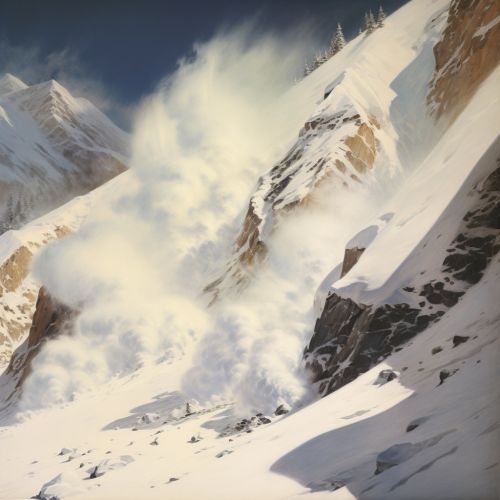Avalanche dynamics
Introduction
Avalanche dynamics refers to the study of the physical properties and behavior of avalanches, a rapid flow of snow down a slope. This field of study is crucial in understanding the causes, propagation, and potential destructive power of avalanches, which pose a significant risk in mountainous regions worldwide.
Formation of Avalanches
Avalanches are formed when a layer of snow becomes unstable and separates from the underlying snowpack. This instability can be caused by various factors, including new snowfall, wind deposition, temperature fluctuations, and the mechanical failure of the snowpack itself. The study of these factors and their interactions is a key aspect of avalanche dynamics.


Types of Avalanches
There are several types of avalanches, each with distinct characteristics and behaviors. The two main types are slab avalanches and loose snow avalanches.
Slab Avalanches
Slab avalanches are the most dangerous type of avalanche. They occur when a cohesive slab of snow breaks away from the snowpack. The slab can be triggered by a small disturbance and can propagate across a slope rapidly. The dynamics of slab avalanches are complex and involve the study of snowpack stability, fracture mechanics, and the propagation of cracks.
Loose Snow Avalanches
Loose snow avalanches, also known as point-release avalanches, start from a single point and gather snow as they descend the slope. These avalanches are typically less destructive than slab avalanches but can still pose a risk, especially to individuals in their path.
Avalanche Propagation
The propagation of an avalanche refers to how it spreads across a slope once it has been triggered. This process is influenced by several factors, including the slope angle, the snowpack's mechanical properties, and the presence of weak layers within the snowpack. Understanding these factors is crucial in predicting the potential size and path of an avalanche.
Avalanche Modeling
Avalanche modeling is a critical tool in avalanche dynamics, used to predict the behavior of avalanches under various conditions. These models incorporate complex physical processes, including snowpack stability, fracture propagation, and fluid dynamics. They are used in avalanche forecasting and hazard assessment, helping to mitigate the risk posed by avalanches.
Avalanche Mitigation
Avalanche mitigation refers to the measures taken to reduce the risk and impact of avalanches. These measures can include both proactive strategies, such as avalanche control and zoning, and reactive strategies, such as rescue and recovery operations. The effectiveness of these measures is heavily influenced by our understanding of avalanche dynamics.
Conclusion
Avalanche dynamics is a complex field that combines elements of meteorology, physics, and geology. It is crucial for understanding the behavior of avalanches and mitigating their risks. As climate change continues to alter weather patterns and snowfall rates, the study of avalanche dynamics will remain a vital area of research.
